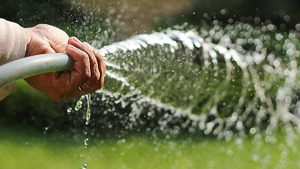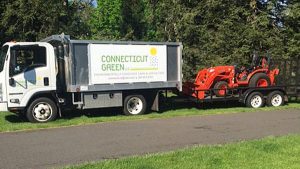Weeds are the worst. Whether they’re sprouting up across your lawn or invading your flower beds, they’re an awful pest. Some people obsess about them, going outside every day to pull the dandelions out from between their cosmos or fretting over the crabgrass that never seems to be controlled. Others just mulch over them and hope for the best!
For the team at Connecticut Green, weeds are the cause of a great deal of stress and heartache because there are few things that upset our customers more. No one wants weeds! The truth is, not all weeds can be avoided. We can prevent some, and we can treat some once they start growing, but we can’t prevent all weeds. It’s just not possible. Crabgrass and chickweed are preventable, but some other weeds have to be treated after they’ve reared their ugly green heads.
Crabgrass is probably the most common weed, and the most despised. It can make any lawn look less-than-lovely. Fortunately, it can be treated before it germinates, so you may never have to see it. Crabgrass can also be prevented by having a complete lawn care program in place: a thick, healthy lawn doesn’t allow enough oxygen or water for grassy weeds to take root. Stressed lawn is a prime target for hostile takeover!
Weeds come in two main varieties, broadleaf and grassy. Grassy weeds, like the aforementioned crabgrass, can be treated preventatively, but will likely require follow-up treatments along sunny ages. Most broadleaf weeds require curative treatments to control. Here’s a rundown of some the more common ones you might see:
- Plantain: These broadleaf weeds are everywhere! They grow in clusters of oval green leaves that stay close to the ground but may sprout a flower that can grow up to a foot tall. These are the weeds you’ll commonly find at the edge of your driveway.
- Thistle: Bull thistle and Canada thistle are both common and unpleasant. They’re frequently seen in beds and on
 lawns, and recognizable by their spiky purple flowers. Stems can be full of dense, needle-like hairs (ouch!) so be sure to wear gloves if you’re pulling these up on your own.
lawns, and recognizable by their spiky purple flowers. Stems can be full of dense, needle-like hairs (ouch!) so be sure to wear gloves if you’re pulling these up on your own. - Dandelion: Everyone recognizes dandelions, I’m sure! There’s no bright yellow flower that brings us less joy, is there? A member of the daisy family, dandelions can take over your lawn after they morph into their “puffball” phase, blowing seeds here, there and everywhere. Interestingly, dandelions probably came here with early settlers, who planted them for both food and medicinal purposes. (Another thing to be grateful for this Thanksgiving, I guess?)
- Clover: White clover is another common broadleaf weed. It’s interesting to note that apart from being the only weed rumored to deliver good luck (four-leaf clover) clover actually adds nitrogen to the soil, so it’s actually beneficial – for a weed. 2018 has been an especially prolific year for clover, as you may have noticed!
- Creeping Charlie, aka ground ivy: Related to mint, Creeping Charlie is an aggressive, fast-spreading weed. It has scalloped-edge leaves that resemble a geranium. It’s crafty in that it uses two different methods to spread. According to The Spruce, “It spreads both by seeding and by rooting at the nodes that stud its little vines (which means you can spread it via mowing without even realizing it, unless you mow with a bag attachment). It can also spread by rhizomes, a fact to keep in mind when you’re trying to dig it out.”
Of course, there are invasive weeds, as well. These include giant hogweed, which is new to Connecticut. Haven’t heard of giant hogweed? It’s pretty awful, and if you do find it, steer clear. Growing as high as 14 feet with white, umbrella-like blossoms, it’s hard to miss. (You can look at images of giant hogweed here to identify it.) If you come across giant hogweed, do not touch it. It can cause blistering burns, scarring and even blindness! A member of the carrot and parsnip family, giant hogweed is used as an ornamental plant in parts of southeast Asia.
Japanese knotweed is another annoying invasive. These fast-spreading plants aren’t harmful like hogweed, but they does threaten to take over riparian areas, and that’s a problem. In New Haven, the Friends of Edgewood Park have brought in goats to take care of their knotweed problem! “The Japanese knotweed is like candy for them. They will selectively find the Japanese knotweed. So, there were other plants that were around, plenty of them have leaves, but the goats preferred that.” The goats are expected to clear over 2.5 acres of knotweed and other invasive plants, including Japanese honeysuckle and poison ivy.

Of course, you probably don’t need goats to take care of your weed problem. The best way to avoid any weed is to take care of your lawn and garden. Aerate your lawn, water deeply, fertilize regularly. A healthy, stress-free turf will be more resistant to weeds. Beds require more maintenance but stay vigilant! Mulching can help, but pulling is often necessary, too.
And remember, not every weed can be prevented. Even the ones that are preventable can require follow-up treatments. The reason we hate weeds – apart from the fact that they grow exactly where we don’t want them to – is that they’re so stubborn. We use the best products on the market to keep your lawn and garden weed-free, but even then, there are no guarantees. Weather plays a big role in any plants success, and this year, it’s worked in the weeds’ favor! All we can do is our best work, and if the weeds come back, so will we.
If you’re vacationing this summer, we can still come and treat your garden. Let us know, and we’ll stop by and spot spray as needed. Just email us. And of course, if you have any questions or concerns about weed treatments, you can always contact us. We look forward to hearing from you.





